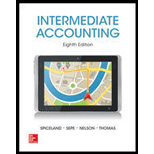
Concept explainers
(1)
Other postretirement benefits: The postretirement benefits which are provided by employers, other than pensions, like medical insurance, life insurance, and legal services, and healthcare benefits, are referred to as other postretirement benefits.
The following are the ways to measure other postretirement benefits:
- Expected postretirement benefit obligation (EPBO): This is the present value of future retirement benefits, which is estimated to be received by the participants.
- Accumulated postretirement benefit obligation (APBO): This is the portion of EPBO recognized by the employee till date.
Postretirement benefit expense: This is an expense to the employer paid as compensation after the completion of services performed by the employees for the other postretirement benefits.
To determine: Postretirement benefit expense for 2016.
(2)
Debit and credit rules:
- Debit an increase in asset account, increase in expense account, decrease in liability account, and decrease in
stockholders’ equity accounts. - Credit decrease in asset account, increase in revenue account, increase in liability account, and increase in stockholders’ equity accounts.
To journalize: Entries related to postretirement benefit expense, funding, and retiree benefits paid
Want to see the full answer?
Check out a sample textbook solution
Chapter 17 Solutions
Intermediate Accounting w/ Annual Report; Connect Access Card
- Can you solve this general accounting problem using accurate calculation methods?arrow_forwardA company had an income of $60,000 using absorption costing for a given period. Beginning and ending inventories for that period were 13,000 units and 18,000 units, respectively. Ignoring income taxes, if the fixed overhead application rate was $3.00 per unit, what was the income using variable costing? A. $75,000. B. $60,000. C. $45,000. D. Not sufficient information to determine.arrow_forwardCan you solve this general accounting problem with appropriate steps and explanations?arrow_forward
- An asset has a book value of $22,500 on December 31, Year 4. The asset has been depreciated at a straight-line rate of $5,000 per year. If the asset is sold on December 31, Year 4 for $19,000, what should the company record? • a. A loss on sale of $3,500 • b. A gain on sale of $3,500 . c. Neither a gain nor a loss is recognized . • d. A loss on sale of $1,000 e. A gain on sale of $1,000arrow_forwardThe audited accounts of Rattle Limited for year-end December 31, 2013, show a profit of $2,400,000 after charging the following: Depreciation $380,000 Legal fees $723,000 Bad debts $67,000 Donations $55,400 Accrued interest $51,000 Foreign travel $75,000 Repair and maintenance $216,000 Premium on insurance $88,000 Other Information: a. - Legal fees of $723,000 are for expenses in respect of the recovery of debts. b. - The company made donations of $55,400 to a registered charity. c. - The bad debt expense is a percentage of debtors at year-end. d. - Foreign travel expense was for a trip by the marketing manager to meet with potential buyers. e. - The capital allowances have been calculated at $142,000 f. - The premium paid of $88,000 was on insurance for the business’ property. g. - There were acquisition expenses of $45,000 associated with the expansion of the business. What is Rattle Ltd.’s corporate tax liability?…arrow_forwardA company's income statement for September reports a net income of $75,000. During the same month, the company paid $15,000 in dividends. If the beginning stockholders' equity was $0, what is the ending balance in stockholders' equity?arrow_forward
- I need the correct answer to this general accounting problem using the standard accounting approach.arrow_forwardI need help with this general accounting question using standard accounting techniques.arrow_forwardIf the risk-free rate is 0.02, the market risk premium is 0.07, and the beta of the stock is 1.2, what is the return of the stock?arrow_forward
- I am trying to find the accurate solution to this financial accounting problem with appropriate explanations.arrow_forwardAssume that Juanita is indifferent between investing in a corporate bond that pays 10.20 percent interest and a stock with no growth potential that pays a 6 percent dividend yield. Assume that the tax rate on dividends is 15 percent. What is Juanita's marginal tax rate?arrow_forwardI am trying to find the accurate solution to this general accounting problem with the correct explanation.arrow_forward

 AccountingAccountingISBN:9781337272094Author:WARREN, Carl S., Reeve, James M., Duchac, Jonathan E.Publisher:Cengage Learning,
AccountingAccountingISBN:9781337272094Author:WARREN, Carl S., Reeve, James M., Duchac, Jonathan E.Publisher:Cengage Learning, Accounting Information SystemsAccountingISBN:9781337619202Author:Hall, James A.Publisher:Cengage Learning,
Accounting Information SystemsAccountingISBN:9781337619202Author:Hall, James A.Publisher:Cengage Learning, Horngren's Cost Accounting: A Managerial Emphasis...AccountingISBN:9780134475585Author:Srikant M. Datar, Madhav V. RajanPublisher:PEARSON
Horngren's Cost Accounting: A Managerial Emphasis...AccountingISBN:9780134475585Author:Srikant M. Datar, Madhav V. RajanPublisher:PEARSON Intermediate AccountingAccountingISBN:9781259722660Author:J. David Spiceland, Mark W. Nelson, Wayne M ThomasPublisher:McGraw-Hill Education
Intermediate AccountingAccountingISBN:9781259722660Author:J. David Spiceland, Mark W. Nelson, Wayne M ThomasPublisher:McGraw-Hill Education Financial and Managerial AccountingAccountingISBN:9781259726705Author:John J Wild, Ken W. Shaw, Barbara Chiappetta Fundamental Accounting PrinciplesPublisher:McGraw-Hill Education
Financial and Managerial AccountingAccountingISBN:9781259726705Author:John J Wild, Ken W. Shaw, Barbara Chiappetta Fundamental Accounting PrinciplesPublisher:McGraw-Hill Education





